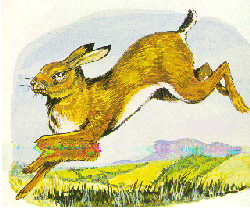
 The
Brown Hare (Giorria) --:
The
Brown Hare (Giorria) --:
It is very difficult to
recognise the difference between the brown hare and the Irish hare. So you
must keep your eyes wide open, when you see one in the countryside. The
brown hare is larger than the Irish hare, has longer ears and it is blackish
in colour towards its tail. You should really bring a pair of binoculars
with you if you really want to see any animal or bird properly. This brown
hare is not as common in Ireland as the Irish hare. It was brought into
Ireland from mainland Europe. Sometimes people call it the English hare as
it came to Ireland from England little while ago. The brown hare appeared on
the old Irish 3d coin, which was silver in colour. The brown hare may travel
far from its home to find some food. The brown hare changes colour in winter
to a light grey.
Hares live in the open fields and mountains. They do not normally burrow but live on the ground surface in tufts of grass known as “forms”. By not having a burrow they can live in wetter areas than rabbits. They have great eyesight and are very fast runners. They use their speed if their enemies are chasing them across fields. They are sometimes chased for miles by hunting dogs, who do it for the fun. Hares eat plant like food. They have two pairs of sharp front teeth, which they use to nibble their food.
The breeding season happens in the springtime of the year. At this time of the year you might be lucky enough to see a few males in groups, sparring, kicking and chasing each other around the place. It is from this carry on that you will often hear the expression “as mad as a March hare”. Female hares have about two or three babies, called leverets in a litter. They can have more than one litter in a year. The brown hare can usually be found in lower land rather than mountain areas. It is also found mainly in the south of Ireland, in counties like Tipperary, Kilkenny, Waterford and Cork. The hare can cause trouble by nibbling the tops of young trees. This annoys the forestry people so they have to put a special fence around new forestry places to keep out the likes of hares and rabbits.
The hare is protected by the
Wildlife Act of 1976 and you are not allowed hunt them.
Shane
Fleming